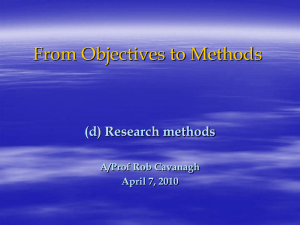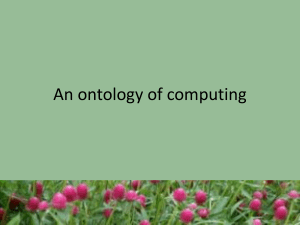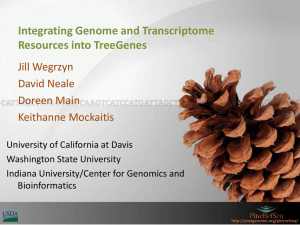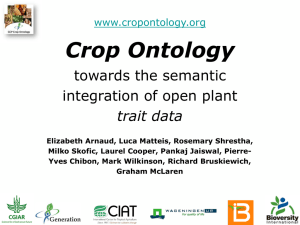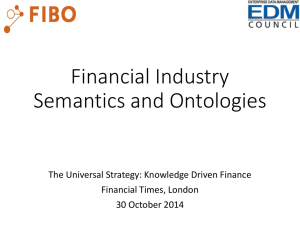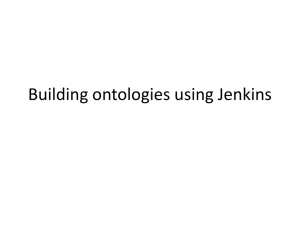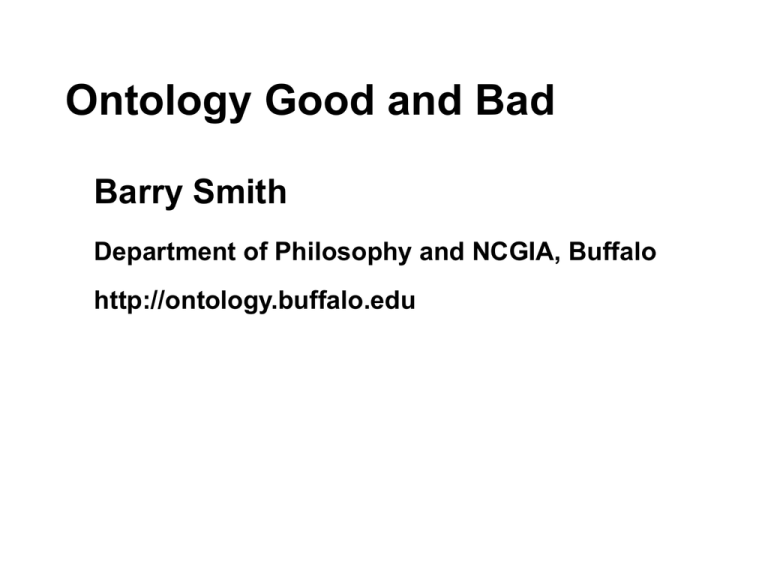
Ontology Good and Bad
Barry Smith
Department of Philosophy and NCGIA, Buffalo
http://ontology.buffalo.edu
Ontology as a branch of
philosophy
the science of what is
the science of the kinds and structures
of objects, properties, events,
processes and relations
Ontology seeks to provide a
definitive and exhaustive
classification of entities in all
spheres of being.
It seeks to answer questions
like this:
What classes of entities are needed for a
complete description and explanation of
the goings-on in the universe?
Ontology is in many respects
comparable to the theories
produced by science
… but it is radically more
general than these
It can be regarded as a kind of
generalized chemistry or biology
(Aristotle’s ontology grew out of
biological classification applied to what
we would now call common-sense
reality)
Aristotle
Aristotle
first ontologist
first ontology (from Porphyry‘s Commentary on
Aristotle‘s Categories)
Ontology is distinguished from
the special sciences in that it
seeks to study all of the
various types of entities
existing at all levels of
granularity
and to establish how they hang
together to form a single whole
(‘reality’ or ‘being’)
Ontology is essentially crossdisciplinary
Methods of ontology:
the development of theories of wider or
narrower scope
the testing and refinement of such
theories
– by logical formalization (as a kind of
experimentation with diagrams)
– by measuring them up against difficult
counterexamples and against the results of
science and observation
Sources for ontological
theorizing:
thought experiments
the study of ancient texts
most importantly: the results of natural
science
more recently: controlled experiments
on folk ontologies
From Ontology to Ontological
Commitment
For Quine, the ontologist studies, not
reality,
but scientific theories
… ontology is then the study of the
ontological commitments or
presuppositions embodied in the
different natural sciences
Quine: each natural science
has its own preferred
repertoire of types of objects
to the existence of which it is
committed
Quine: only natural sciences
can be taken ontologically
seriously
The way to do ontology is
exclusively through the investigation
of scientific theories
All natural sciences are
compatible with each other
Growth of Quine-style
ontology outside philosophy:
Psychologists and anthropologists (and
cognitive geographers) have sought
to elicit the ontological commitments
(‘ontologies’, in the plural) of different
cultures and groups.
They have sought to establish what
individual subjects, or entire human
cultures, are committed to, ontologically,
in their everyday cognition
PROBLEM:
All natural sciences are in large degree
consistent with each other
Thus it is reasonable to identify ontology
– the search for answers to the
question: what exists? – with the study
of the ontological commitments of
natural scientists
The identification of ontology with the
study of ontological commitments still
makes sense when one takes into
account also certain commonly shared
commitments of common sense (for
example that fish or cows exist)
But this identification of ontology
becomes strikingly less defensible when
the ontological commitments of various
specialist groups of non-scientists are
allowed into the mix.
How, ontologically, are we to
treat the commitments of
astrologists, or clairvoyants, or
believers in leprechauns?
NEW SECTI ON
NEW SECTION
Ontology and Information
Science
Some background:
procedural vs. declarative controversy
What is the most suitable form of
representation for
knowledge/cognition/intelligence?
Proceduralists: the way to create intelligent
machines is by instilling as much knowledge
of how into a system as possible
Declarativists: artificial intelligence is best
arrived at by instilling as much knowledge of
what into a system as possible.
Leading early declarativists: Minsky, McCarthy,
Pat Hayes, Doug Lenat (CYC)
Both the procedural and the
declarative elements of computer
systems can be viewed as
representations:
Programs are representations of
processes (e.g. in a bank),
Data structures are representations of
objects (e.g. customers)
The Ontologist’s Credo:
To create effective representations
it is an advantage if one knows
something about the objects and
processes one is trying to represent.
The Ontologist’s Credo:
To create effective representations
it is an advantage if one knows
something about the objects and
processes one is trying to represent.
This means
that one must know something about the
specific token objects (employees, taxpayers,
domestic partners) recorded in one’s
database,
but also
something about objects, properties and
relations in general, and also about the general
types of processes in which objects,
properties and relations can be involved.
The growth of ontology
reflects efforts to look beyond the
artefacts of computation and information
to the big wide world beyond
It parallels in some respects the growth
of object-oriented software,
where the idea is to organize a program
in such a way that its structure mirrors
the structure of the objects and
relationships in its application domain.
NEW SECTI ON
ANOTHER NEW SECTION
The Tower of Babel Problem
Different groups of system designers have their
own idiosyncratic terms and concepts by means
of which they represent the information they
receive.
The problems standing in the way of putting this
information together within a single system
increase geometrically.
Methods must be found to resolve terminological
and conceptual incompatibilities.
The term ‘ontology’
came to be used by information scientists to
describe the construction of a canonical
description of this sort.
An ontology is a dictionary of terms
formulated in a canonical syntax and with
commonly accepted definitions and axioms
designed to yield a shared framework for use
by different information systems communities.
Above all: to facilitate portability
Ontology =
a concise and unambiguous description
of the principal, relevant entities of an
application domain and of their potential
relations to each other
Enterprise ontology
Ontology used to support enterprise
integration:
To make its systems intercommunicable, a
large international banking corporation needs
a common ontology in order to provide a
shared framework of communication
But objects in the realms of finance, credit,
securities, collateral are structured and
partitioned in different ways in different
cultures.
Some successes of ontology
Aristotle
ONTEK (Chuck Dement, Peter Simons)
LADSEB (Nicola Guarino)
GOL (Heinrich Herre, Wolfgang Degen)
ONTEK: Ontology of Aircraft
Construction and Maintenance
Ontek’s PACIS system embraces within a
single framework
aircraft parts and functions
raw-materials and processes involved in manufacturing
the times these processes and sub-processes take
job-shop space and equipment
an array of different types of personnel
the economic properties of all of these entities
PACIS
NOMENCLATURE
PACIS METASYSTEMATICS
(CLADE)
SO FAR
SO GOOD
The Birth of Bad Ontology
In the 1980s “Ontology” begins to be used for
a certain type of conceptual modeling
How to build ontologies?
By looking at the world, surely (Good
ontology)
Well, No
Let’s build ontologies by looking at what
people think about the world
Ontology becomes a branch of KR
Work on building ontologies as
conceptual models pioneered in Stanford:
KIF (Knowledge Interchange Format)
(Genesereth)
and Ontolingua (Gruber)
Arguments for Ontology as
Conceptual Modeling
Ontology is hard.
Life is short.
Since the requirements placed on information
systems change at a rapid rate, work on the
construction of corresponding ontologies of
real-world objects is unable to keep pace.
Therefore, we turn to conceptually defined
surrogates for objects, which are easier
modeling targets
In the world of information
systems there are many
surrogate world models and
thus many ontologies
… and all ontologies are equal
Traditional ontologists are
attempting to establish the
truth about reality
The shortened time horizons of
ontological engineers lead to a
neglect of the standard of truth
in favor of other, putatively
more practical standards, such
as programmability
A good ontology
is built to represent some pre-existing domain
of reality, to reflect the properties of the
objects within its domain
For an administrative information
system
there is no reality other than the one created
through the system itself, so that the system
is, by definition, correct
Ontological engineers thus
accept the closed world
assumption:
a formula that is not true in the
database is thereby false
The definition of a client of a bank is:
“a person listed in the database of bank
clients”
The system contains all the
positive information about the
objects in the domain
The system becomes a world unto itself
Only those objects exist which
are represented in the system
Gruber (1995): ‘For AI systems
what “exists” is what can be
represented’
The objects in closed world
models can possess only
those properties which are
represented in the system
But this means that these objects
(for example people in a database)
are not real objects of flesh and
blood at all
They are denatured surrogates,
possessing only a finite number of
properties (sex, date of birth, social
security number, marital status,
employment status, and the like)
Tom Gruber:
An ontology is:
‘the specification of a conceptualisation’
It is a description (like a formal
specification of a program) of the
concepts and relationships that can
exist for an agent or a community of
agents.
(Note confusion of ‘object’ and
‘concept’)
We engage with the world in a
variety of different ways: we
use maps, specialized
languages, and scientific
instruments. We engage in
rituals, we tell stories.
Each way of behaving involves a
certain conceptualisation:
a system of concepts or
categories in terms of which the
corresponding universe of
discourse is divided up into
objects, processes and relations
Examples of conceptualizations:
in a religious ritual setting we might use
concepts such as God, salvation, and sin
in a scientific setting we might use concepts
such as micron, force, and nitrous oxide
in a story-telling setting we might use
concepts such as: magic spell, leprechaun,
and witch
Such conceptualizations are
often tacit
An ontology is the result of making
them explicit
Ontology concerns itself not at
all with the question of
ontological realism
It cares about conceptualizations
It does not care whether they are
true of some independently
existing reality.
Ontology deals with ‘closed
world data models’ devised
with specific practical
purposes in mind
And all of such surrogate
created worlds are treated by
the ontological engineer as
being on an equal footing.
For the purposes of the
ontological engineer the
customer is always right
It is the customer, after all, who
defines in each case his own
world of surrogate objects
The ontological engineer aims
not for truth, but rather, merely,
for adequacy to whatever is the
pertinent application domain
as defined by the client
ATTEMPTS TO SOLVE THE
TOWER OF BABEL PROBLEM
VIA ONTOLOGIES AS
CONCEPTUAL MODELS HAVE
FAILED
WHY?
LEPRECHAUNS AGAIN:
There are Good and Bad
Conceptualizations
There need be no common factor
between one conceptualization
and the next
(there is no common factor between the
conceptualization of physics and the
conceptualization of leprechauns)
Not all conceptualizations are
equal.
There are bad
conceptualizations, rooted in:
error
myth-making
astrological prophecy
hype
bad dictionaries
antiquated information systems
based on dubious foundations
These deal in large part only
with created pseudo-domains,
and not with any reality
beyond
Consider the methods for
‘automatically generating
ontologies’ currently much
favored in certain information
systems circles
How to make an ‘ontology’
1. Take two or more large databases
or standardized vocabularies
relating to some domain
2. Use statistical or other methods to
‘merge’ them together
3. Wave magic wand
4. Ignore the fact that existing large
databases and standardized
vocabularies embody systematic
errors and massive ontological
unclarities
5. Do not tell your audience that the
results of integrating such errors
and unclarities together is likely to
be garbage
NEW SECTI ON
ANOTHER RED SLIDE
SIGNS OF HOPE:
Some ontological engineers (ONTEK,
LADSEB, GOL) have recognized that
they can improve their methods by
drawing on the results of the
philosophical work in ontology carried
out over the last 2000 years
They have recognized
that the abandonment of the Closed World
Assumption may itself have positive
pragmatic consequences
What happens if ontology is directed not
towards mutually inconsistent
conceptualizations, but rather towards the
real world of flesh-and-blood objects?
The likelihood of our being able to build a
single workable system of ontology is much
higher
It is precisely because good
conceptualizations are
transparent to reality
that they have a reasonable chance
of being integrated together in robust
fashion into a single unitary
ontological system.
The real world thus itself plays a
significant role in ensuring the
unifiability of our separate ontologies
But this means
that we must abandon the attitude of
tolerance towards both good and bad
conceptualization
How to do ontology:
we have to rely, opportunistically, on the
best endeavors of natural scientists,
But exploiting also the relates of
empirical investigations of the folk
ontology of common sense
NEW SECTI ON
END
Ontology in this connection
goes by other names
It is similar to work on what are called
‘schemata’ in database design,
or on ‘models of application domains’ in
software engineering,
or on ‘class models’ in object-oriented
software design.
Other ontology applications
navigation in large libraries (for example
of medical or scientific literature)
natural language translation (goal of a
central target language)
For Aristotle, as for Quine, the
term ‘ontology’ can exist only
in the singular
To talk of ‘ontologies’, in the plural, is
analogous to confusing mathematics
with ethnomathematics
There are not different biologies, but
rather different branches of biology.


